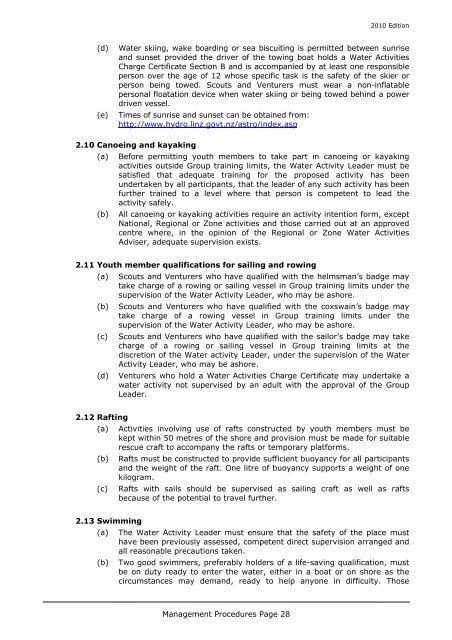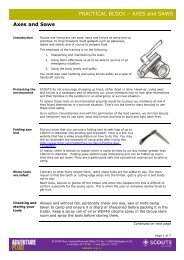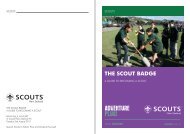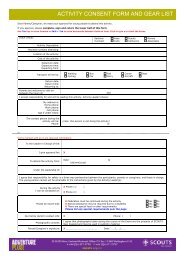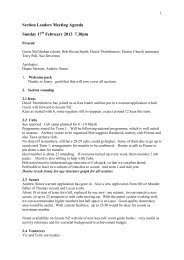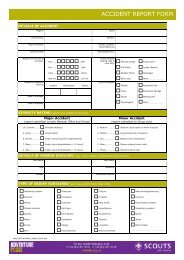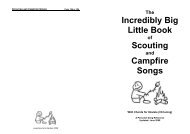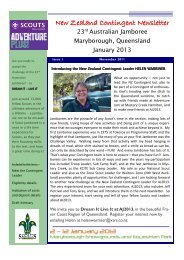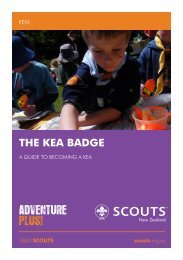The_Rule_Book - Brooklyn Scouts, Wellington
The_Rule_Book - Brooklyn Scouts, Wellington
The_Rule_Book - Brooklyn Scouts, Wellington
Create successful ePaper yourself
Turn your PDF publications into a flip-book with our unique Google optimized e-Paper software.
2010 Edition<br />
(d)<br />
(e)<br />
Water skiing, wake boarding or sea biscuiting is permitted between sunrise<br />
and sunset provided the driver of the towing boat holds a Water Activities<br />
Charge Certificate Section B and is accompanied by at least one responsible<br />
person over the age of 12 whose specific task is the safety of the skier or<br />
person being towed. <strong>Scouts</strong> and Venturers must wear a non-inflatable<br />
personal floatation device when water skiing or being towed behind a power<br />
driven vessel.<br />
Times of sunrise and sunset can be obtained from:<br />
http://www.hydro.linz.govt.nz/astro/index.asp<br />
2.10 Canoeing and kayaking<br />
(a) Before permitting youth members to take part in canoeing or kayaking<br />
activities outside Group training limits, the Water Activity Leader must be<br />
satisfied that adequate training for the proposed activity has been<br />
undertaken by all participants, that the leader of any such activity has been<br />
further trained to a level where that person is competent to lead the<br />
activity safely.<br />
(b) All canoeing or kayaking activities require an activity intention form, except<br />
National, Regional or Zone activities and those carried out at an approved<br />
centre where, in the opinion of the Regional or Zone Water Activities<br />
Adviser, adequate supervision exists.<br />
2.11 Youth member qualifications for sailing and rowing<br />
(a) <strong>Scouts</strong> and Venturers who have qualified with the helmsman’s badge may<br />
take charge of a rowing or sailing vessel in Group training limits under the<br />
supervision of the Water Activity Leader, who may be ashore.<br />
(b) <strong>Scouts</strong> and Venturers who have qualified with the coxswain’s badge may<br />
take charge of a rowing vessel in Group training limits under the<br />
supervision of the Water Activity Leader, who may be ashore.<br />
(c) <strong>Scouts</strong> and Venturers who have qualified with the sailor’s badge may take<br />
charge of a rowing or sailing vessel in Group training limits at the<br />
discretion of the Water activity Leader, under the supervision of the Water<br />
Activity Leader, who may be ashore.<br />
(d) Venturers who hold a Water Activities Charge Certificate may undertake a<br />
water activity not supervised by an adult with the approval of the Group<br />
Leader.<br />
2.12 Rafting<br />
(a) Activities involving use of rafts constructed by youth members must be<br />
kept within 50 metres of the shore and provision must be made for suitable<br />
rescue craft to accompany the rafts or temporary platforms.<br />
(b) Rafts must be constructed to provide sufficient buoyancy for all participants<br />
and the weight of the raft. One litre of buoyancy supports a weight of one<br />
kilogram.<br />
(c) Rafts with sails should be supervised as sailing craft as well as rafts<br />
because of the potential to travel further.<br />
2.13 Swimming<br />
(a) <strong>The</strong> Water Activity Leader must ensure that the safety of the place must<br />
have been previously assessed, competent direct supervision arranged and<br />
all reasonable precautions taken.<br />
(b) Two good swimmers, preferably holders of a life-saving qualification, must<br />
be on duty ready to enter the water, either in a boat or on shore as the<br />
circumstances may demand, ready to help anyone in difficulty. Those<br />
Management Procedures Page 28


